Incidental Speakers
eContact! 21.2 — Dematerialization of the Sounding Object: Conceptual approaches to sound-based artistic practices (July 2023) http://econtact.ca/21_2/apel_incidentalspeakers.html
In his 2009 book In the Blink of an Ear: Toward a non-cochlear sonic art, Seth Kim-Cohen made an appeal for conceptual approaches in electroacoustic practices. As a sound artist trained in electroacoustic traditions, I took Kim-Cohen’s proposition as an implicit challenge to both interrogate my own work and grapple with aspects of our “sound in-itself” culture. The resulting interrogation has taken the form of an ongoing series of non-sounding loudspeakers that engage with the dominant ideas and assumptions of the “mainstream” — in both academic and non-academic terms — electroacoustic traditions encountered throughout the Western world. Specifically, these non-sounding loudspeakers function as individual sculptures or sculptural elements within a visual arts context while also summoning the æsthetic contexts of electroacoustic music and sound art. My aim here is twofold: to show that by creating sonic art without a sound component, the piece could more easily be interpreted as a conceptual work about sound rather than a work engaged with the qualities of sound in-itself; and to demonstrate that by separating sound from our experience of sonic artworks, we can more easily examine our shared sonic conceptions.
Kim-Cohen argues that “sound in-itselfism” is prevalent in experimental music, electroacoustic music and sound art practices. He encourages the electroacoustic musician to “be a good partner” and engage with the “social, political, and historical, conditions [of] ‘the world.’” (Kim-Cohen 2013, 25) Further, he argues that the meaning of sound-in-itself-based works are assumed to be self-evident but are in fact highly contingent on their relation to external conditions. To develop a specific meaning for a sound, an artist should accordingly acknowledge and engage with these relationships.
While this call is certainly important and still appropriate, even for works that do attempt to engage with these external conditions, there is a consideration that makes responding to it difficult in practice. Listeners themselves have their own tendency to impose a sound-in-itself mode of listening on even the most severe of conceptually derived sonic works. I believe it is part of John Cage’s æsthetic legacy that sounds presented in an artistic context are listened to as musical sounds no matter what the source or the intention of the artist. One Cage anecdote in particular demonstrates this compellingly. American sculptor Robert Morris shared his conceptual sound art piece Box with the Sound of Its Own Making (1961) with the composer and reports that “When Cage came, I turned it on… and he wouldn’t listen to me. He sat and listened to it for three hours and that was impressive to me. He just sat there.” (Berger 1989, 31) Although Cage (here as a listener, not as a composer) is aware of the conceptual intention of the work, he enacts a sound-in-itself reverence for the sound of the work despite the more obvious reading of the work as a critique of romantic conceptions of the art object consistent with the conceptual art movement of which it was part.
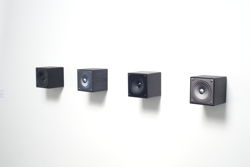
I have also witnessed this sound-in-itself tendency in listeners’ — and my own! — perception of and responses to my concept-based sound installations. In 589 and 589.6, for example, the light of a sodium-vapour lamp (with wavelengths of 589.0 nm and 589.6 nm) is accompanied by sine tones of frequencies 589.0 Hz and 589.6 Hz. This work is intended as a critique of numerologically based sonification techniques. However, discussions with listeners have revealed that the droning interval of the two sine tones is generally interpreted in the context of musical minimalism, microtonality or acoustic interference patterns. For me, these two examples strongly suggest that the mere presence of sound in an artwork can set the context for sound-in-itself listening modes. Overcoming this can be a significant hurdle for electroacoustic practitioners and sound artists working with conceptual ideas in their works.
My central idea was to avoid this complication by producing works that do not produce sound yet nevertheless engage with our sonic culture and electroacoustic practices. The form I choose for these works was the loudspeaker itself, whose raison d’être is the production of sound and whose use is implicated in so much of our sound-in-itselfism. Each work of the series Incidental Speakers takes as its starting point a 9 cm black cubic loudspeaker that normally has a single speaker driver mounted in one face. This design evokes the form of the consumer “surround sound” loudspeaker that was ubiquitous in the early 21st century. These works are not connected to amplifiers or wired in any way to make sound. Here, the physical silence of these speakers is not to be confused with Cageian silence or other kinds of musical silences, but is rather simply the inevitable result of the inherent non-sounding nature of the materials used to construct them. The form of the loudspeaker engages with the viewer’s acts and history of listening, allowing variations of this form to allude to different sonic conceptions — and meanings. Each of the seven works 1[1. Only a selection of the series is explored here; new works continue to be added to the series.] discussed below addresses different sonic conceptions: representation, acousmatic sound, loudspeaker artifice, listening modes, “transmodal” listening, and the materiality of sound.
The Loudspeakers
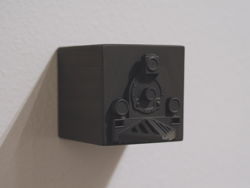
I attempt to set a conceptual framework for this series of works in One and Four Speakers by overtly referencing Joseph Kosuth’s One and Three Chairs. In Kosuth’s work, a chair is presented along with a photograph of the same chair and the printed words of a dictionary definition of a chair. His work is not concerned with the form and materiality of the chair as much as how meaning is created through different forms of representation. In One and Four Speakers, a carved solid wooden sculpture of an entire loudspeaker, an oil painting of an entire loudspeaker, an actual loudspeaker, and a photograph of a loudspeaker cone and mount are presented (Fig. 1). Here the actual loudspeaker serves as both a referent of the other depictions of the speaker and as a symbol of sound itself. Sound produced through loudspeakers is not commonly conceptualized as a representation of sound; the artist expects the listener to perceive the sound as the artistic “product” itself. For example, a live performance with sound “reinforcement” is not viewed as a depiction of a concert but rather — and despite the mediation obvious to all present — the concert itself. By contextualizing sound within the traditional forms of the visual arts (sculpture, painting and photography) we re-examine the representational aspects of electronic sound production.
Pierre Schaeffer’s iconic Études aux chemins de fer is recognized as the first work of musique concrète in the Schaefferian school. The subjective nature of the acousmatic listening experience is depicted as a loudspeaker-train hybrid in Schaeffer (Fig. 2). The dark form of the cube can be seen as an abstract form or, alternatively, as a train emerging from the cubic speaker. Brian Kane suggests that “acousmaticity is ultimately a judgment of the listener, not an intrinsic quality of the sound itself” (Kane 2014, 225). This work articulates the dichotomy of this judgement by framing it in a sculptural context. Such a framing highlights the unsettled dichotomy between forms of acousmatic listening that do not require “reduced” listening and those that do.
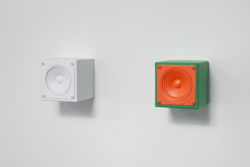
Another of the author’s works that addresses acousmatic listening is Production Reproduction (Fig. 3). Here, the contribution of the loudspeaker itself to the acousmatic impression is examined. The widespread “loudspeaker orchestra” approach to the “live” presentation of electroacoustic works habitually employs loudspeakers that are conceived of (and are meant to remain) as invisible reproducers of sound. 2[2. The acousmonium perhaps provides a counter example, as the nature of the sound reproduction in individual speakers comprising such diffusion systems can in fact draw the listeners’ attention to the specific materials and form of their construction.] This conception is reinforced by the typical design of loudspeakers as a box with a black veil covering the front face in which the speaker cone itself is mounted. 3[3. Indeed, the origin of the word “acousmatic” is found in the Greek akousmatikoi, referring to the obligation of students of Pythagoras to listen in silence as he lectured them from behind a veil, the idea being that devoid of visuals they could concentrate better on the content of his teachings.]
In opposition to this, some sound art works use loudspeaker arrangements that are intended to emphasize the sound’s cause or meaning. One example is Nigel Helyer’s Silent Forest, in which loudspeakers fashioned as air raid sirens are used to contextualize the sounds of the installation. The work deals with the Vietnam War and its ecological impact. Among sounds of western opera, the natural environment and record scratches, the sound and sight of air raid sirens binds the sonic and visual elements of the installation (Wilson 2002, 415). In Production Reproduction, one speaker is painted to blend with the wall and another is painted with bright “safety orange” and green. In the first case, the white colour further camouflages the artifice of the loudspeaker technology that accommodates acousmatic listening modes. The bright colours of the second draw attention to the loudspeaker as a specific producer of sound, with the sound’s attendant source, cause and context easily discerned. Here, without sound, we can see how the speaker itself can contribute to this distinction.
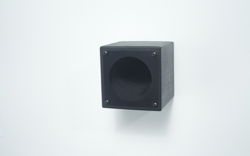
In the early 20th century, recording and sound-transmitting technologies made it possible for sounds to be heard in spaces different from those where they were created. It became possible to create the illusion of one sonic space in another by exploiting an ever-widening range of recording and transmission technologies. Through the increasingly complex convergence of the tools and means of creation, representation and presentation of acousmatic work, the listener is given the opportunity to imagine real or fantastical spaces. In Acoustic Space, the virtual acoustic space that can be created by electronic sound reproduction is represented by a loudspeaker with a cone that extends 30 cm beyond the back of the speaker box into the wall upon which it is mounted, creating a physical space that is larger than the speaker box itself (Fig. 4). The illusion of acoustic space that can be created with electronic sound reproduction is thus brought into the nonvirtual world by creating an “impossibly” large speaker box. Here we can reflect on the ubiquitous illusion of depth and representation in virtual acoustic spaces created with an analogous “trick” in the physical world.
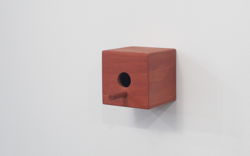
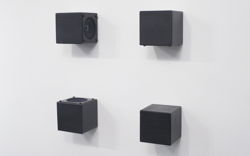
Michel Chion’s three listening modes, a widely recognized schema for classifying ways of listening (Chion 1994, 25), are interpreted with loudspeaker arrangements in Modes. The first interpretation suggests Chion’s “causal listening” mode by evoking birdsong with its configuration as a brightly coloured birdhouse (Fig. 5). The second mode, “semantic listening”, is evoked by a box configuration of four speakers, each pointing to the next in a recursive manner (Fig. 6). This is intended to be reminiscent of the children’s game “telephone”, in which the semantic content of a message is slowly garbled as it is whispered by one child to the next and errors in comprehension and transmission are incorporated in the process. Finally, “reduced listening” is represented by a completely closed speaker enclosure, with neither a speaker driver nor a speaker mount (Fig. 7). The minimalist blankness of the black cube is here meant to represent the non-referentiality of Chion’s “reduced listening” mode:
The emotional, physical, and æsthetic value of a sound is linked not only to the causal explanation we attribute to it but also to its own qualities of timbre and texture, to its own personal vibration. (Chion 1994, 31)
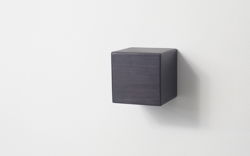
However, by examining and reading these listening modes as physical objects entirely devoid of sound, I believe we can see that each of the modes is dependent on its own, unique context for its interpretation. Notably, the black box representing reduced listening is “reduced” materially in relation to our common cultural understanding that a speaker must be comprised of, among other things, a (sound-producing) speaker driver. Lacking this context, the black box could represent any of our culturally dependent understandings of a “black box”.
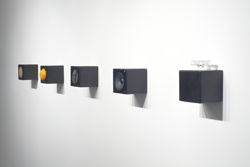
The five senses that Aristotle describes, in his treatise De Anima (ca. 350 BCE), humans and animals as having are depicted in the context of the loudspeaker in Senses (Fig. 8). Touch is depicted as a loudspeaker with sandpaper in lieu of a driver, taste is depicted as a loudspeaker with an orange (fruit) as a protruding cone, sight is depicted as a mirror loudspeaker, smell is depicted through a loudspeaker box fashioned as a bottle of perfume with a glass stopper “sealing” the top, and hearing is depicted as an entirely unadorned and otherwise unaltered loudspeaker. Looking at the five senses depicted in the context of sound (understood as a component of only one of Aristotelian senses), we reconsider the classical separation of the senses. By viewing other modes of sensation in the context of the sound mode, we may imagine what contribution these sensations make to the nature of our listening and our listening experience. In discussing space in acousmatic music, Denis Smalley points out that non-auditory senses “spill over into sonic experience.” He says that this
transmodal linking occurs automatically when the sonic materials seem to evoke what we imagine to be the experience of the world outside the music. (Smalley 2007, 39)
That is, other percepts can be part of our sonic perception, what Dugal McKinnon calls the “nonsounding dimensions of the sonic” (McKinnon 2013, 71). In sound artist Cristine Sun Kim’s video [Closer Captions] she captions a shot of a shower with “[the sound of shampoo scent floating among the fog]” (Sun Kim 2020). Sun Kim is here going one step further and pointing to a type of transmodal listening that is not dependent on sound and in which other modes of perception are welcome — in this case, smell as part of the act of listening, and even contributing to a more complete understanding of the visuals. Here in Senses, similarly, we can contemplate modes of listening in which each or all the senses are allowed to impact what is heard.
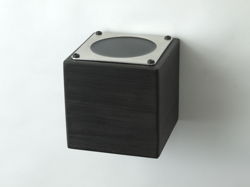
In Medium, a loudspeaker enclosure is arranged with the speaker cone side facing upwards (Fig. 9), but with no speaker cone actually installed. The entire speaker enclosure is filled to the rim of the opening with liquid black ink. In this work the ink represents the physical material of sound, making sound visible while maintaining its fluidity. The liquid in this arrangement is typically not perceived at first glance as a liquid. With time, its nature as an undulating substance is revealed as movements perturb the surface. By portraying sound as a visible yet visually impenetrable substance, I wish to recontextualize the capacity of acousmatic sounds to occlude the source and cause of a sound. The black ink prevents us from seeing objects that might exist in it, yet we see the ink itself. This seems close to how acousmatic technology has encouraged the rise of sound-in-itself listening modes.
Conclusion
In the works discussed here, I have subjected my own sound art practice to a non-sounding mandate in order to explore concepts of sound without relying on sound-in-itself-based listening modes or on the sounds’ (possible) inherent sonic qualities.
Clement Greenburg’s well-known idea of medium specificity is a tenet of our understanding of modernism in the visual arts. The acousmatic tradition in music and sound art does not challenge this idea. As the visual arts made the “conceptual turn” in the 1960s, music’s conceptual works of the period were sometimes misinterpreted as forms of sound-in-itselfism (cf. the Cage example above). Seth Kim-Cohen’s challenge for us to “embrace conceptualism” pushed me to attempt to ensure that my works about sound could only be meaningfully interpreted in a conceptual framework. For me, this, quite ironically, meant forgoing sound as a material or component in my sonic art practices. If Kim Cohen’s goal in advocating for conceptual sound practices is to promote a shared cultural understanding of a work, then working without sound should, at minimum, ensure that the intention of a work will not be lost to a sound-in-itself interpretation. For me, these works have clarified my working process in my subsequent works that do create sound, providing me with the provocative question: “Could you create this work without sound?” If my answer is “no”, then I know that my sonic conception for the work is unduly, or at least predominantly, focused on the sound of the sound.
Bibliography
Berger, Maurice. Labyrinths: Robert Morris, Minimalism and the 1960s. New York: Harper & Row, 1989.
Chion, Michel. Audio-Vision: Sound on Screen. Trans. Claudia Gorbman. New York NY: Columbia University Press, 1994. http://www.jstor.org/stable/10.7312/chio18588
Kane, Brian. Sound Unseen: Acousmatic sound in theory and practice. Oxford: Oxford University Press, 2014. http://doi.org/10.1093/acprof:oso/9780199347841.001.0001
Kim-Cohen, Seth. In the Blink of an Ear: Toward a non-cochlear sonic art. New York: Continuum International Publishing, 2009.
_____. “The Chladni Ostrich.” ICMC 2012 — “Non-Cochlear Sound”. Proceedings of the 38th International Computer Music Conference (Ljubljana, Slovenia: IRZU — Institute for Sonic Arts Research, 9–14 September 2012). In Array, the Journal of the International Computer Music Association (2013) pp. 25–36. Available at http://www.computermusic.org/media/documents/array/array13_14.pdf (Accessed 17 April 2023)
McKinnon, Dugal. “Dead Silence: Ecological silencing and environmentally engaged sound art.” Leonardo Music Journal 23 (December 2013) “Sound Art,” pp. 71–74. http://www.jstor.org/stable/43832509
Smalley, Denis. “Space-Form and the Acousmatic Image.” Organised Sound 12/1 (April 2007) “Practice, process and æsthetic reflection in electroacoustic music,” pp. 35–58. http://doi.org/10.1017/S1355771807001665
Sun Kim, Christine. [Closer Captions] (2020). YouTube video “Artist Christine Sun Kim Rewrites Closed Captions” (3:16) posted by “Pop-Up Magazine” on 13 October 2020. http://youtu.be/tfe479qL8hg
Wilson, Stephen. Information Arts: Intersections of art, science, and technology. Cambridge MA: The MIT Press, 2002. http://doi.org/10.7551/mitpress/3765.001.0001
Social top